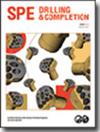基于粒子群优化时变滤波经验模态分解的随钻测量泥浆脉冲信号去噪与提取方法
IF 1.2
4区 工程技术
Q3 ENGINEERING, PETROLEUM
引用次数: 2
摘要
目前,泥浆脉冲传输广泛应用于井下无线传输。为了在钻井过程中更准确地提取原始钻井液脉冲信号,本文提出了一种基于粒子群优化时变滤波经验模式分解(TVFEMD)的最优去噪整形算法。TVFEMD的性能在很大程度上取决于其参数(即B样条阶数和带宽阈值)。在传统的TVFEMD方法中,参数是预先给定的,可能不会进行优化,因此很难获得令人满意的分解结果。为了解决这一问题,本文将相关系数作为目标函数,并使用粒子群优化算法对TVFEMD的参数进行优化。首先,使用粒子群优化算法来搜索参数的最佳组合。然后,应用TVFEMD获得了一系列本征模函数。随后,采用最优去噪整形算法,通过低通滤波确定最佳重构信号。以置换熵作为评价指标,得到重建信号。最后,对重构后的信号进行方波整形处理,得到准确的钻井液脉冲信号。该算法的近似值为0.7581,相关性高达0.8535。仿真信号和钻井液脉冲信号分析结果表明,该方法能够准确提取原始脉冲信号。本文章由计算机程序翻译,如有差异,请以英文原文为准。
Measurement While Drilling Mud Pulse Signal Denoising and Extraction Approach Based on Particle-Swarm-Optimized Time-Varying Filtering Empirical Mode Decomposition
At present, mud pulse transmission is widely used in underground wireless transmission. To extract more accurately the original drilling fluid pulse signals while drilling, in this paper, we developed an algorithm for optimal denoising shaping based on particle-swarm-optimized time-varying filtering empirical mode decomposition (TVFEMD). The performance of TVFEMD heavily depends on its parameters (i.e., B-spline order and bandwidth threshold). In the traditional TVFEMD method, the parameters are given in advance and may not be optimized, so it is difficult to achieve satisfactory decomposition results. To tackle this issue, the correlation coefficient was used as the objective function, and the particle-swarm-optimization algorithm was used to optimize the parameters of TVFEMD in this paper. First, the particle swarm optimization was used to search for the best combination of parameters. Then, the TVFEMD was applied to obtain a series of intrinsic mode functions (IMFs). Subsequently, the optimal denoising and shaping algorithm was used to determine the best reconstructed signal by low-pass filtering. Permutation entropy was taken as the evaluation index to obtain a reconstruction signal. Finally, the reconstructed signal was processed by square wave shaping to obtain accurate drilling fluid pulse signals. The approximation of the algorithm is 0.7581, and relevance is as high as 0.8535. The simulation signal and drilling fluid pulse signal analysis results showed that the proposed approach can extract the original pulse signal accurately.
求助全文
通过发布文献求助,成功后即可免费获取论文全文。
去求助
来源期刊

SPE Drilling & Completion
工程技术-工程:石油
CiteScore
4.20
自引率
7.10%
发文量
29
审稿时长
6-12 weeks
期刊介绍:
Covers horizontal and directional drilling, drilling fluids, bit technology, sand control, perforating, cementing, well control, completions and drilling operations.
 求助内容:
求助内容: 应助结果提醒方式:
应助结果提醒方式:


